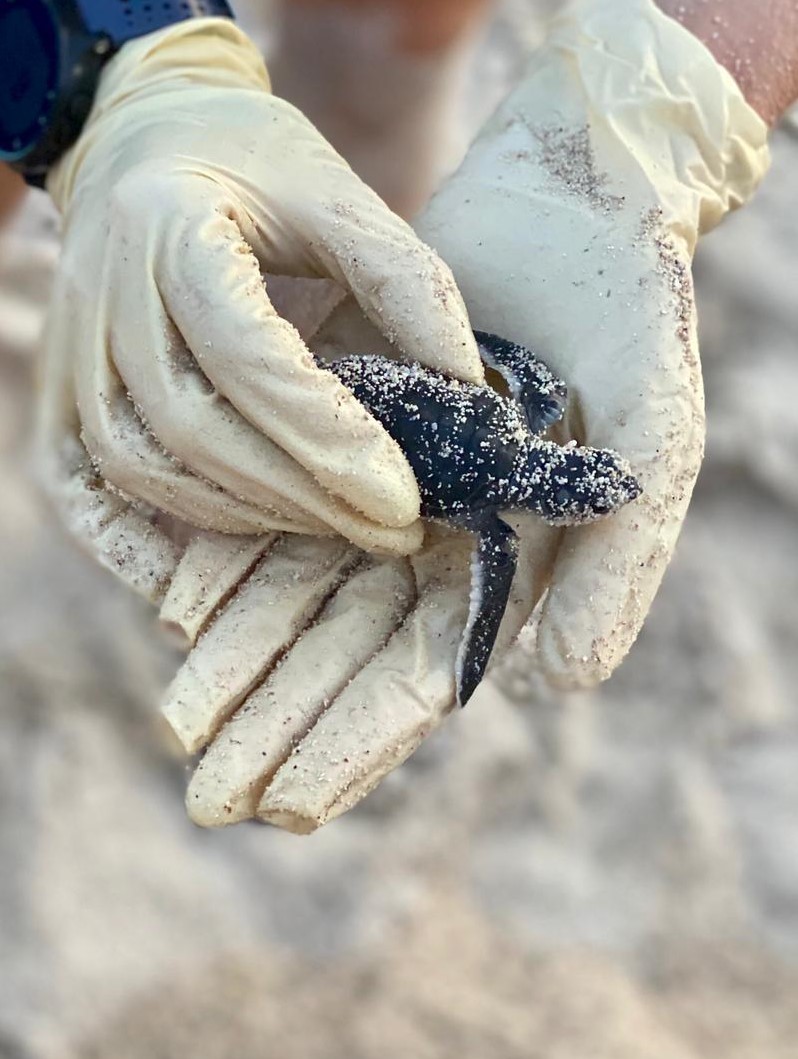2020 Turtle Record Season
2020 Turtle Season: a record year

The Department of Environment (DoE) reports a record turtle season in its efforts to protect endangered sea turtles in the Cayman Islands. The DoE’s Sea Turtle Monitoring programme has been in operation since 1998, when they began conducting systematic annual surveys of our beaches to identify signs of turtle nesting. This year broke several records and reflects the ongoing success of the programme.
The season started in an unusual way, with the Cayman Islands in lockdown and beaches closed. Although this presented a number of challenges for the monitoring team, it meant that nesting turtles had little to no disturbances on the beaches and this positive impact was reflected by nesting occurring in new locations.


Towards the end of the season, a number of tropical storms and passing hurricanes threatened nests and the DoE’s Turtle Team were kept very busy assessing nest safety, and where necessary, relocating nests to safer locations. Despite the team’s best efforts, high seas caused more than 30 nests to become inundated with varying impacts to the hatch, and 10 nests were completely washed away due to unpredictable and significant beach erosion during the storm season.
On Grand Cayman, the 2020 turtle nesting season was a record with 506 confirmed nests. This included 345 green turtle nests, 156 loggerhead turtle nests, and 5 hawksbill turtle nests. For the endangered green turtles, it was the most nests recorded in a season since monitoring began. Although the increasing number of nests does correlate to an increase in the number of nesting turtles, each female can lay up to nine nests in a season and therefore the size of the nesting population is still very small.
Cayman Brac also had a successful season with 51 confirmed nests which included 41 loggerhead, 8 green, and 2 hawksbill turtle nests. This was also a new record for green turtle nest numbers by one nest. Additionally, Cayman Brac recorded the latest nest on record for the three islands, as a hawksbill nest was discovered on Christmas Eve. The DoE were unfortunately unable to confirm the total number of nests from Little Cayman for the 2020 season due to pandemic related staff capacity restrictions.
Poaching remains an ongoing threat to the adult females when they are attempting to nest and are killed for illegal sale. DoE’s conservation officers remained vigilant throughout the season and undertook several turtle rescues and intercepted a poaching attempt thereby saving the turtle.
The DoE is extremely grateful for the support of the more than 40 regular volunteers who supported the programme by walking beaches to report tracks, assisting with data collection, and helping DoE staff to protect nests and conserve our sea turtles.
ENDS.
Quick stats from Grand Cayman’s turtle nesting season
- Total season length (nesting and hatching): 7 months and 24 days
- Total confirmed nests: 506 (156 loggerhead, 345 green, and 5 hawksbill)
- Total eggs counted: 56,290
- Total hatched egg shells counted: 43,803
- Total nests relocated to protect from storm surge: 53
Quick stats from Cayman Brac’s turtle nesting season
- Total season length (nesting and hatching): 9 months and 19 days *hatch date estimated for final nest
- Total confirmed nests: 51 (42 loggerhead, 8 green, and 2 hawksbill)
- Total eggs counted: 5,688
- Total hatched egg shells counted: 3,604
- Total nests relocated to protect from storm surge: 8
Timeline of the Cayman Islands’ 2020 turtle nesting season
19th April – The season began with the first loggerhead nest discovered by the police helicopter using aerial footage on Seven Mile Beach during the lockdown.
4th May – Cayman Brac’s nesting season began with their first loggerhead nest.
25th May – The first green turtle nest on Grand Cayman is laid and is the earliest green turtle nest on record. Usually green turtles begin nesting in mid-June.
2nd September – The nesting record on Grand Cayman is broken as the 469th nest is laid.
19th September – The DoE celebrated the 500th nest on Grand Cayman.
4th– 6th October – Hurricane Delta approaches and passes the Cayman Islands bringing high seas and prompting emergency relocation of ~20 nests.
24th – 26th October – Hurricane Zeta brings more bad weather and high seas, further threatening and destroying some nests.
18th December – The final nest on Grand Cayman is excavated.
24th December – Cayman Brac had a late hawksbill nest on Christmas Eve!
Additional Information
Once nests are identified by the DoE’s Turtle Monitoring Team, measurements are taken of the location, and an assessment of the nest is made including natural threats such as distance from the water line, and human threats such as property lighting that could misdirect hatchlings away from the sea when they emerge. The nest is monitored for threats such as bonfires and heavy equipment on beaches, and then excavated post-hatch to assess the health and success of the hatch.
The DoE has recorded nests for several species of sea turtles including loggerhead turtles which are listed as vulnerable, green turtles which are listed as endangered, and hawksbill turtles which are listed as critically endangered by the International Union for Conservation of Nature (IUCN). Historical records indicate that leatherback turtles were once present in the Cayman Islands, however, since monitoring began in 1998, no leatherback nests have been recorded and they are now considered locally extinct. Given the precarious status of our sea turtle population, Cayman’s efforts must continue to preserve these sea turtles for our future generations.





